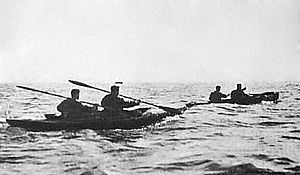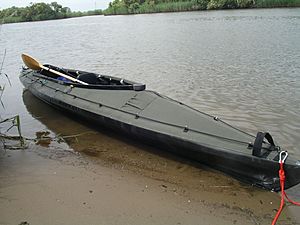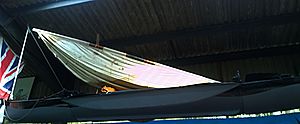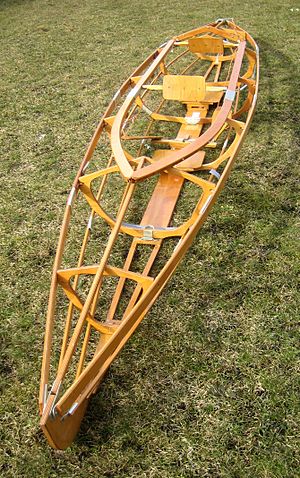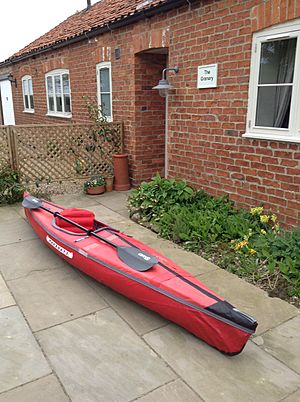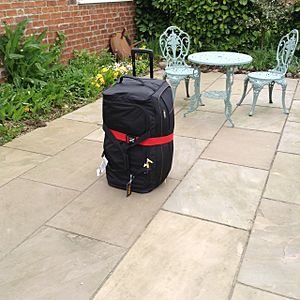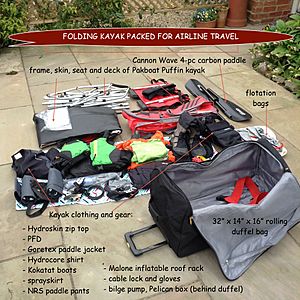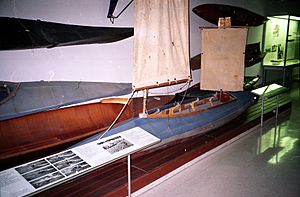Folding kayak facts for kids
A folding kayak is a special type of kayak that you can fold up! Imagine a boat that can fit into a few bags. It's like a modern version of the kayaks first made by the Inuit people, who used animal skins over frames of wood and bone.
Today's folding kayaks have frames that can collapse. These frames are made from strong materials like wood, aluminum, and plastic. The outer skin is a tough, waterproof fabric. Many even have air chambers inside, which makes them almost impossible to sink!
Contents
History of Folding Kayaks
The First Folding Kayaks
The very first working folding kayak was created in 1905 by Alfred Heurich. He was a German student studying architecture. Heurich paddled his new boat on the Isar River in Germany. The next year, he got a patent for his design, which he called the Delphin (meaning "Dolphin").
The Delphin had a frame made of bamboo and a hull (the bottom part) made of sailcloth. It could be folded into three bags, and each bag weighed less than 4.5 kg (10 lb)!
A man named Johannes Klepper made folding kayaks very popular. His factory in Germany started making them in 1906. Klepper kayaks were loved because they were easy to carry and didn't take up much space. Years later, in the 1930s, Oskar Speck used folding kayaks from another company, Pionier-Faltboot-Werft, for his amazing seven-year journey from Germany all the way to Australia!
Folding Kayaks in World War II
During the Second World War, special forces from Britain and other countries used kayaks. They were used in secret missions in places like Europe and Southeast Asia. About a dozen special kayaks were developed for these forces. They were given the secret name Cockle.
Some of these Cockle kayaks were the "frame-and-fabric" type, like modern folding boats. The Mk 2 Cockle could collapse along its 4.5-meter (15-foot) length to just about 18 cm (7 inches)! This Mk 2 was famously used in Operation Frankton in 1942, where soldiers attacked ships in Bordeaux, France.
Around the same time, Walter Höhn in Switzerland started building his own folding kayaks in 1924. He moved to Australia in 1928 and brought his designs with him. During the war in the Pacific, Höhn's company built over 1,000 folding kayaks, called 'folboats', for the Australian military. These 'folboats' were used in many secret missions, including Operation Jaywick and Operation Rimau.
Modern Folding Kayaks
The Klepper Aerius II model was first made in 1951 and is still produced today! In 1956, Dr. Hannes Lindemann crossed the entire Atlantic Ocean in an Aerius II. This showed how strong and reliable folding kayaks could be.
Because they are light and don't use metal, folding kayaks are often chosen by military special forces. Companies like Nautiraid, Klepper, and Long Haul make special models for military use. A newer design from TRAK Kayaks in Canada uses a special system that lets you change the shape of the boat's hull while you're paddling!
Today, there are about ten main companies that make folding kayaks. Some well-known brands include Klepper, Triton Advanced, Long Haul, Nautiraid, Pakboats, Pouch, and TRAK.
How Folding Kayaks are Designed
Most folding kayaks are built in a similar way, even if they use different materials. The frame can be made of wood, aluminium tubes, or different plastics. Some newer ones even use carbon fiber.
The frame usually has solid pieces at the front (bow) and back (stern). Many smaller pieces called "ribs" connect to longer poles called "longeron"s. Many designs, like those from Klepper, also have folding floorboards and side pieces to make the boat stronger and give it shape.
Many folding kayaks also use air "sponsons." These are like inflatable tubes that help tighten the skin around the frame and can even change the shape of the boat a little.
The skin of a folding kayak usually has two parts: the deck (top) and the hull (bottom). The deck can be made of a fabric like cotton or a coated synthetic material. The hull is usually made of a very strong, coated synthetic fabric like Hypalon or polyurethane. The way the hull is stretched tight over the frame is important for how well the kayak performs. One company, TRAK, even has hydraulic jacks in the frame to let you change the hull's shape!
Putting a folding kayak together can take anywhere from 8 minutes to about 45 minutes, depending on the design and how much practice you've had. Taking it apart usually takes about half that time.
The Oru Kayak is a unique folding kayak that uses the idea of origami (paper folding). It's made from a single sheet of plastic that folds up to become a carrying case when you're not using it.
Folding kayaks are also very stable and strong, which makes them great for sailing, especially when going with or against the wind. Remember, Dr. Hannes Lindemann sailed most of the way across the Atlantic!
How Folding Kayaks Perform
Folding kayaks are known for being very tough, stable, and lasting a long time. For example, the Klepper Aerius I was used for white-water kayaking many years ago, even before modern plastic boats existed, because it was so durable and easy to steer. Some well-cared-for Klepper kayaks have been used for over 50 years!
While some people who use hard kayaks might not see folding kayaks as the same, folding kayaks actually feel a lot like the original skin-and-frame boats made by the Inuit people. They are very close to those traditional boats.
The speed of a folding kayak depends on its design. Some can be as fast as regular sea kayaks made from fiberglass. Generally, folding kayaks might be a little slower in calm water than hard kayaks of the same size. This is because the air sponsons in many folding kayaks make them wider, which can create more drag and slow them down a bit.
However, folding kayaks are great in rough water! When a hard kayak hits waves, it can slow down. But the flexible frame and skin of a folding kayak can absorb the energy of the waves. This helps the boat move more easily through choppy water and ride over waves instead of crashing into them. Folding kayaks also give you a closer feeling of being connected to the water.
Two big advantages of folding kayaks are how light and portable they are. Most models weigh much less than hard kayaks of the same size. When taken apart, most can be packed small enough to store in a closet, fit in a car trunk, or even be checked as luggage on an airplane! Even if you have to pay extra baggage fees, it's often cheaper than renting a boat when you travel. For example, the 12-foot Pakboat Puffin solo kayak weighs only 24 pounds and can fit in a bag that meets airline rules, with room for your gear!
Famous Owners
Did you know that a folding kayak once belonged to Pope John Paul II? It's been on display at a museum in Poland since 2003. When he was a cardinal, the future pope shared this kayak, nicknamed "The Pebble," with a friend.
As mentioned before, the German doctor Hannes Lindemann crossed the Atlantic Ocean in 1956 using a Klepper Aerius II folding kayak. That very kayak is now on display at the Deutsches Museum in Germany.
See also
- Folding boat
- Hannes Lindemann
- Operation Frankton
- Operation Jaywick
- Operation Rimau
- Oskar Speck
- Sea kayak
- Sea sock


